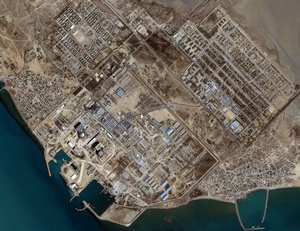U.S. Options
In dealing with the prospect of a nuclear-armed Iran, the United States has two basic options: either freeze the Iranian nuclear program with hopes of rolling it back (and constraining it to peaceful applications), or live with the program while containing its negative impacts. On the freeze/rollback side, the prospects for more than a temporary pause are not promising, in our estimation. As long as significant sections of the Iranian program remain opaque, it will be difficult to gauge the success of a diplomatic rollback strategy; and, of course, it would be easier to apply a strategy to prevent Iran from crossing the nuclear threshold than to try to reverse acquisition after the fact. Granted, a nuclear-armed Iran could be subject to increasingly onerous restrictions—ranging from diplomatic isolation and economic sanctions to military force and regime change. Military strikes or covert action could also be used to change Iran’s strategic direction or provoke regime change. The likelihood of success using these means, however, is low. Even if there were to be a new government in Iran, it would likely continue to pursue advanced nuclear capabilities, including at some point a weapon. However, an overt regime-change strategy would carry an extremely high risk that the Iranian regime would use its nuclear weapon in a last-ditch attempt to save itself.
Could the United States live with a nuclear-armed Iran? Due to U.S. strategic predominance, many experts believe the Iranian regime would be unlikely to use its nuclear capability overtly unless it faced what it perceived to be an imminent and overwhelming threat. An Iran emboldened by nuclear weapons might become more assertive in the region, but superior U.S. conventional capabilities and strengthened regional partnerships would probably deter Iran from significant mischief, such as closing the Strait of Hormuz or attacking U.S. forces directly. The United States has options short of war that it could employ to deter a nuclear-armed Iran and dissuade further proliferation. These include reassuring allies and friends in the region, strengthening active and passive defenses, improving preemption and rapid response capabilities, and reenforcing nonproliferation incentives and counterproliferation activities. Nevertheless, the lack of confirmable information on Iran’s leaders, particularly on how they make decisions, what they fear, if they have a concept of deterrence, or whether they appreciate implicit redlines set by countries with whom they have no contact—the United States and Israel—makes forecasting this issue very difficult.
Finally, while some security experts, predominantly Israeli, fear that Iran’s leaders would provide terrorists with nuclear weapons, we judge, and nearly all experts consulted agree, that Iran would not, as a matter of state policy, give up its control of such weapons to terrorist organizations and risk direct U.S. or Israeli retribution. Many specialists on Iran share a widespread feeling that Iran’s desire to be seen as a pragmatic nuclear power would tend to rein in whatever ideological impulses it might otherwise have to disseminate nuclear weapons or technologies to terrorists. There is less agreement, however, on whether the regime in Tehran could reliably control all elements within the Iranian system that might have the means, motive, and opportunity to do so.
Arguably, the costs of rollback might be higher than long-term containment of a nuclear-armed Iran. The United States would be expected to offer incentives to Iran and to governments cooperating with its strategic choices in what could be a long period of rollback. Even if the United States decides to embark on a rollback strategy, it would have to maintain a deterrence strategy while other diplomatic, economic, and military options played out. The good news is that many of the capabilities needed for deterrence and containment are the same as those needed for more robust military options. That may enable the United States to play both strategies for an undetermined length of time.
In our reexamination of the strategic implications for U.S. security policy and planning in the event Iran completes plans for nuclear weapons development, two sets of questions kept intruding on our research. The first involves the discussions between the EU–3 and Iran: What is the full extent of the European Union’s bargaining position; are there more carrots than sticks; would it remain firm in its dealings with an obstreperous Iran; could it possibly succeed in gaining Iran’s commitment to end its efforts to acquire the full cycle of nuclear weapons production; and what would happen if the EU effort fails?
In various unofficial meetings between European, American, and Iranian scholars, the Iranians have accused the Europeans of betraying them to the Americans in order to improve EU–U.S. relations, which had been disrupted by European opposition to the 2003 Iraq war. The Europeans have countered that their objection to Iranian acquisition of nuclear weapons technology is not directed solely against Iran; rather, it is meant to prevent all new acquisition efforts. If Iran crosses the nuclear weapons threshold, the European representatives said in unison, then the Non-Proliferation Treaty and, indeed, all non- or counterproliferation regimes will be finished. Surely, they ask, Iran could understand the great danger the spread of nuclear weapons posed to everyone. Clearly, the idea that the United States and the Europeans were in consensus on this issue had caught the Iranians’ attention. To offer some insight into the delicate negotiations between the EU–3 and Iran, we have added to this study a timeline describing Iran’s historic path to nuclear power and an appendix on
"Iran’s Nuclear Program: Status, Risks, and Prospects".
The second question frequently asked concerns Israel’s perception of an Iranian nuclear threat and its options in dealing with what it describes as the greatest danger to its security today. To offer special insight on this issue, we include a paper by Israeli scholar Gerald Steinberg entitled
"Walking the Tightrope: Israeli Options in Response to Iranian Nuclear Developments".









Bookmarks